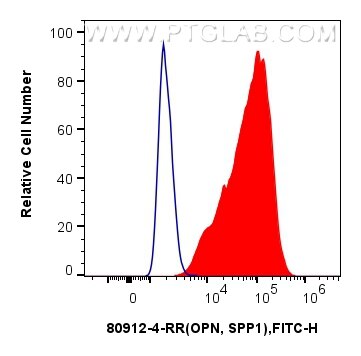Anticorps Recombinant de lapin anti-Osteopontin
Osteopontin Recombinant Antibody for WB, FC (Intra), Indirect ELISA
Hôte / Isotype
Lapin / IgG
Réactivité testée
Humain, rat, souris
Applications
WB, FC (Intra), Indirect ELISA
Conjugaison
Non conjugué
CloneNo.
6B11
N° de cat : 80912-4-PBS
Synonymes
Galerie de données de validation
Informations sur le produit
80912-4-PBS cible Osteopontin dans les applications de WB, FC (Intra), Indirect ELISA et montre une réactivité avec des échantillons Humain, rat, souris
| Réactivité | Humain, rat, souris |
| Hôte / Isotype | Lapin / IgG |
| Clonalité | Recombinant |
| Type | Anticorps |
| Immunogène | Osteopontin Protéine recombinante Ag19216 |
| Nom complet | secreted phosphoprotein 1 |
| Masse moléculaire calculée | 314 aa, 35 kDa |
| Poids moléculaire observé | 70 kDa, 44-66 kDa |
| Numéro d’acquisition GenBank | BC007016 |
| Symbole du gène | Osteopontin |
| Identification du gène (NCBI) | 6696 |
| Conjugaison | Non conjugué |
| Forme | Liquide |
| Méthode de purification | Purification par protéine A |
| Tampon de stockage | PBS only |
| Conditions de stockage | Store at -80°C. 20ul contiennent 0,1% de BSA. |
Informations générales
Osteopontin (OPN), also known as SPP1, is a secreted glycophosphoprotein that belongs to the small integrin-binding ligand N-linked glycoprotein (SIBLING) family. Originally isolated from bone, OPN has been found in kidneys, vascular tissues, biological fluids, and various tumor tissues (PMID: 15138464; 16406521). OPN can interact with CD44 and integrins and regulate diverse biological processes. It has a multifaceted role in bone development and remodeling, and is also involved in the inflammatory and immune response, oncogenesis and cancer progression. The very acidic nature of OPN, as well as the presence of variable posttranslational modifications, has led to anomalous migration in SDS-polyacrylamide gels and therefore to reports of different molecular weights for OPN (PMID: 8293561). Depending on the cell and tissue source and/or the SDS-PAGE system, OPN migrates with a molecular weight of 44-80 kDa, as well as at some smaller bands corresponding to peptide fragments (PMID: 8195113; 17890765).







